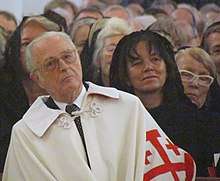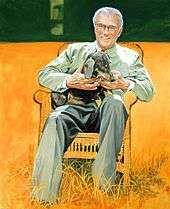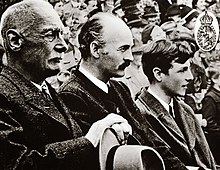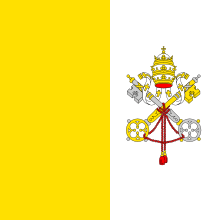Franz, Duke of Bavaria
Franz Bonaventura Adalbert Maria Herzog von Bayern (born 14 July 1933), commonly known by the courtesy title Duke of Bavaria, is the head of the House of Wittelsbach, the former ruling family of the Kingdom of Bavaria. His great-grandfather King Ludwig III was the last ruling monarch of Bavaria until deposed in 1918.
| Franz | |
|---|---|
| Duke of Bavaria | |
 Franz wearing the ceremonial robes of the Order of the Holy Sepulchre, 2012 | |
| Head of the House of Wittelsbach | |
| Tenure | 8 July 1996 – present |
| Predecessor | Albrecht, Duke of Bavaria |
| Heir presumptive | Prince Max, Duke in Bavaria |
| Born | 14 July 1933 Munich, Nazi Germany |
| House | Wittelsbach |
| Father | Albrecht, Duke of Bavaria |
| Mother | Countess Maria Draskovich of Trakostjan |
Franz was born in Munich. During the Second World War, the Wittelsbachs were anti-Nazi.[1] The family initially left Nazi Germany for Hungary but were eventually arrested when Germany invaded the country in 1944. Franz was 11 at the time. He spent time in several Nazi concentration camps, including Sachsenhausen concentration camp, then Flossenbürg concentration camp and finally Dachau.[1]
After the war, Franz was a student at the University of Munich and became a collector of modern art. Franz succeeded as head of the House of Wittelsbach, and as pretender to the Bavarian throne, on the death of his father in 1996. He lives at the Nymphenburg Palace in Munich and Berg Castle. Franz is not married.[2]
Birth
Franz was born on 14 July 1933 in Munich, the son of Albrecht, Duke of Bavaria, and his morganatic wife, Countess Maria Draskovich of Trakostjan of the House of Drašković, a Croatian noble family. On 18 May 1949, when Franz was 15, his grandfather Crown Prince Rupprecht recognised the marriage of Franz's parents as dynastic, and Franz became a prince of Bavaria.
The Wittelsbach dynasty were opposed to the Nazi regime in Germany, and in 1939, Franz's father took his family to Hungary. They lived in Budapest for four years before moving to their Castle at Sárvár in late 1943. In March 1944, Nazi Germany occupied Hungary, and on 6 October 1944 the entire family, including the 11-year-old Franz, were arrested. They were sent to a series of Nazi concentration camps, including Oranienburg and Dachau. At the end of April 1945, they were liberated by the United States Third Army.[3]
Education

After the war, Franz received his secondary education at the Benedictine Abbey of Ettal. He then studied business management at the University of Munich and in Zurich. Franz developed a passion for collecting modern art. Items from his private collection are on permanent loan to the Pinakothek der Moderne in Munich.[4] He is also an honorary trustee of the Museum of Modern Art in New York.[1]
Current activities
His 80th birthday party, in 2013, was held at the Schleissheim Palace near Munich. The party was attended by 2,500 guests,[5] including the then-incumbent Minister-President of Bavaria, Horst Seehofer.[6]
In 2016, he became the donor of the project of restoration of the Statue of St. John of Nepomuk in Divina, Slovakia, realised under auspices of the Embassy of the Federal Republic of Germany in Slovakia. The project was honoured by patronage of Norodom Sihamoni, the king of Cambodia and Simeon II, the last tsar of Bulgaria.[7] The project was completed in the year 2017.[8]
Succession rights
Franz has never married. The heir presumptive to the headship of the House of Wittelsbach is his brother Prince Max, Duke in Bavaria. Because Max has five daughters but no sons, he is followed in the line of succession by his and Franz's first cousin Prince Luitpold[9] and, in the next generation, by the latter's son Prince Ludwig Heinrich of Bavaria (b. 1982).
Link to the Stuarts
Franz is a direct descendant of the House of Stuart. Were it not for the Act of Settlement 1701, Franz would be the successor to the British crowns of the Stuart kings.[10] His spokesman has, however, made it clear that this is a purely 'hypothetical' issue[10] and not a claim that Franz pursues.[10][11][12][13][14]
Titles, styles and honours
Titles and styles

Franz is traditionally styled as His Royal Highness the Duke of Bavaria, of Franconia and in Swabia, Count Palatine of the Rhine.[15][5] [16] [17]
- 14 July 1933 – 8 July 1996: His Royal Highness Prince Franz of Bavaria
- (in Germany): Franz Prinz von Bayern
- 8 July 1996 – present: His Royal Highness The Duke of Bavaria
- (in Germany): Franz Herzog von Bayern
- (by Jacobites): His Majesty King Francis II of England, Scotland, France, and Ireland
Franz was styled Prinz von Bayern at birth.[18] In 1996, after the death of his father, he changed his style to Herzog von Bayern ('Duke of Bavaria').[19]
Honours


.svg.png)
.svg.png)

- House of Habsburg: Knight of the Order of the Golden Fleece
See also
| Wikimedia Commons has media related to Franz, Duke of Bavaria. |
References
- Cowell, Alan (11 July 1996). "Duke Albrecht Is Dead at 91; Pretender to Bavarian Throne". The New York Times. Retrieved 30 November 2013.
- "The blue-blooded Bavarian Duke". www.thelocal.de. The Local. 25 July 2013. Retrieved 10 June 2020.
- Hamilton, Tom (8 April 2008). "German Duke could claim Scots throne". The Daily Record. Retrieved 23 November 2013.
- Carla Schulz-Hoffmann and Peter-Klaus Schuster, Deutsche Kunst seit 1960 aus der Sammlung Prinz Franz von Bayern (München: Prestel-Verlag, 1985).
- "The blue-blooded Bavarian Duke". the local.de. 25 July 2013.
- "Party fit for a king". The Local.de. Retrieved 23 November 2013.
- Sobola, Marek (2017). Príbeh svätojánsky, Socha sv. Jána Nepomuckého v Divine / The Story of St. John, Statue of St. John of Nepomuk in Divina / ដំណើររឿងរបស់ St. John, រូបចម្លាក់ St. John Nepomuk នៅក្រុង Divina / Die Johannisgeschichte, Die Staute des hl. Johannes Nepomuk in Divina / Историята на св. Ян, Статуята на св. Ян Непомуцки в Дивина. Slovakia: Servare et Manere, o. z. & Kysucké múzeum v Čadci. ISBN 978-80-972614-3-6.
- www.tkkbs.sk. "Biskup Galis požehnal obnovenú sochu sv. Jána Nepomuckého v Divine". www.tkkbs.sk. Retrieved 6 August 2017.
- Genealogie des Hauses Wittelsbach. München: Verwaltung des Herzogs von Bayern, 2000.
- Alleyne, Richard; de Quetteville, Harry (7 April 2008). "Act repeal could make Franz Herzog von Bayern new King of England and Scotland". Daily Telegraph. Archived from the original on 17 June 2008. Retrieved 22 June 2008.
- Andrew Neather (10 September 2014). "R.I.P. GB: what happens if Scotland votes Yes in next week's independence referendum?". Evening Standard. Retrieved 23 August 2016.
- Douglas, Jason (19 August 2014). "Scottish Independence: Scots Ponder Secession Question in Referendum". WSJ. Retrieved 23 August 2016.
- Huggler, Justin (17 September 2014). "Could the Duke of Bavaria be the next King of Scotland?". Daily Telegraph. Retrieved 23 August 2016.
- Mudie, Keir. "Independence referendum: Duke of Bavaria in line to be next King of Scotland?". Daily Record. Retrieved 23 August 2016.
- Genealogisches Handbuch des Adels, Band 50, Fürstliche Häuser, Band IX, Limburg an der Lahn 1971, S. 7
- "Hilpoltstein-Botschafter-des-Landkreises". Donaukurier. 20 November 2013. Retrieved 23 November 2013.
- "Musikalisches-Geschlecht". Die Welt. 3 November 2013. Retrieved 23 November 2013.
- Genealogisches Handbuch des Adels, Band 50, Fürstliche Häuser Band IX. Limburg an der Lahn: C. A. Starke, 1971, page 7.
- Genealogisches Handbuch des Adels, Band 141, Fürstliche Häuser Band XVIII. Limburg an der Lahn: C. A. Starke, 2007, page 2.
- "Der Bundespräsident / Terminkalender / Ordensverleihung an Franz Herzog von Bayern". Bundespraesident.de (in German). Retrieved 26 July 2017.
- "Archived copy". Archived from the original on 24 November 2018. Retrieved 25 June 2017.CS1 maint: archived copy as title (link)
- "Photographic image" (JPG). Merkur.de. Retrieved 26 July 2017.
- "Verleihung des Verdienstordens von Rumänien an Herzog Franz von Bayern | BOTSCHAFT VON RUMÄNIEN in der Bundesrepublik Deutschland". Berlin.mae.ro. 18 July 2017. Retrieved 26 July 2017.
- "Photographic image" (JPG). Berlin.mae.ro. Retrieved 26 July 2017.
Bibliography
- Adalbert, Prinz von Bayern. Die Wittelsbacher: Geschichte unserer Familie. München: Prestel, 1979.
.jpg)